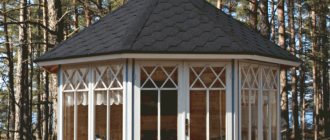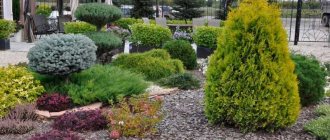Where does the plant look best?
In the wild, astilbe can be found in dense deciduous forests and along the banks of reservoirs. It perfectly tolerates moderately moist soil and shaded areas, which makes it possible to plant this plant near an artificial lake and in gardens with tall trees and shrubs.
This amazing plant, in addition to its luxurious forms, also has several colors, which allows you to decorate almost any flower bed or lawn in various styles and directions. The range of astilbe shades is small:
- white,
- soft peach,
- pink,
- lilac,
- deep scarlet.
But this does not bother landscape designers, who invariably use the plant in their projects.
Here are some planting options featuring this flower, as well as combinations of astilbe with other plants.
Astilbe: photo and description
The plant belongs to the Saxifraga family , astilbe's natural habitat is the banks of streams in the deciduous forests of North America, East Asia and Japan.
It follows that the bush prefers high humidity. According to data posted in various sources, the genus Astilbe contains from 18 to 40 species of plants.
The flower owes its name to Lord Hamilton. The titled Scottish botanist fixed the matte color of its leaf blades in the name of the bush: literally the name astilbe is translated as “devoid of shine .
The flower was brought to Europe at the very end of the 18th – beginning of the 19th centuries by lovers of rare flora representatives Carl Thunberg and von Silbold.
Astilbe itself is a rhizomatous perennial, i.e. at the end of the season, all the stems with leaves and inflorescences of the plant die off. The height of the plant depends on the species characteristics.
There are varieties whose size barely reaches 10 cm, but there are also varieties whose growth approaches 200 cm.
Astilbe also differs in the structure of its long-petioled leaf blades, jagged along the edge. They can be:
- simple;
- twice pinnate;
- thrice feathery.
The color of the leaves of the plant also depends on the varietal characteristics and can be dark green or reddish green .
The developed rhizome of astilbe can be lignified or loose. Every year, new buds form on the upper part, while the lower part of the root dies.
Important! Don’t miss the moment and be sure to sprinkle the exposed part of the root with soil in the fall.
The root grows by 3–5 cm per year, depending on the variety.
Classification of plants by type of flowering:
- early - flowering occurs at the very end of June;
- medium - bushes delight the owner with blossoming panicles in July;
- late - flowers bloom in August.
Astilbe flowers are small, delicate and collected in large apical inflorescences.
Astilbe in roadside flower beds and borders
Tall fluffy astilbe, planted along garden paths, looks impressive and original both in the company of other flowers and shrubs, and among plantings consisting exclusively of its different subspecies and varieties.
Astilbe in mixborders
The spreading panicles of astilbe effectively complement flower and shrub crops in mixed compositions.
A few more examples of the use of astilbe of different varieties and hybrids in landscape design.
Recent Entries
Lilac perennials that are beautiful, compact and do not crowd out other plants Why when buying seedlings you should not take the sellers’ word for it and how to determine the age of the plant using 3 signs Tomato seedlings have turned purple or whitish: why the color has changed and how to save the plants
As mentioned earlier, astilbe loves moist soil and therefore can be planted near small bodies of water.
When designing a landscape, it is necessary to take into account the compatibility of plants. Astilbes are especially expressive in tandem with hosta, barberry, spirea, fern and juniper.
Care
Astilbe is a very unpretentious plant. Caring for it comes down to weeding while the flower is still small. Subsequently, when the bush has grown sufficiently, the need to weed the planting will no longer be necessary. The clumps are so dense that weeds cannot grow through them.
All varieties of astilbe require a large amount of moisture. The plant needs regular and abundant watering. During dry periods, water in the morning and evening, and to ensure less moisture evaporates, carefully mulch the plantings.
Inflorescences can be removed after flowering, although this is not necessary. Dried panicles are beautiful and can decorate a flower garden until frost. In October, foliage and stems must be cut off at soil level and the rhizomes covered with mulch. This will help protect the flower rhizomes from freezing. Young astilbe plantings can be additionally covered with spruce branches, but adult plants do not require such cover.
Experienced gardeners recommend rejuvenating astilbe plantings every 5 years. This can be done both in spring and autumn. The bush needs to be dug up and the rhizome divided into small sections. The plant tolerates replanting very well and blooms the next year.
Astilbe bushes near the trees
Astilbes look advantageous in the shade of the crown of large deciduous and coniferous trees, against the background of large and medium-sized shrubs.
Astilbes and hostas
Tall, slender astilbes go well with hostas with wide, bright leaves. These plants complement each other very favorably.
Tandem with juniper
Against the background of coniferous juniper, astilbe looks especially elegant, attracting the eye and being a bright accent in the composition.
Examples of design of naturgardens and park areas.
Astilbe is one of those flowering perennials that does not require complex care and, most importantly, can survive cold winters in open ground. No wonder this beautiful plant is deservedly popular among gardeners and landscape designers.
- Author: Ilona Lukina
Rate this article:
- 5
- 4
- 3
- 2
- 1
(33 votes, average: 4.2 out of 5)
Share with your friends!
The unpretentious queen of shady gardens: astilbe in landscape design
Published Jul 4, 2019
All summer residents dream of a beautiful garden that does not require complex care. Perennial flowers and shrubs come to the aid of experienced designers and novice gardeners. One of the very favorite and unpretentious plants is the spectacular astilbe, whose multi-colored panicles will harmoniously fit into any style of landscape design. The shrub, widespread on many continents, came to Europe from Japan at the turn of the 18th and 19th centuries. The plant, which was brought by lovers of rare flora, by the middle of the last century had firmly won the hearts of biologists, gardeners and florists in our country.
Although the varieties bred by breeders differ in shape, size and color, astilbe cannot be confused with any garden shrub. Fluffy inflorescences on a slender stem resemble the bright feathers of fairy-tale birds. You can decorate almost any free space on the site with graceful flowers.
The plant is undemanding to soil composition and grows even in dense shade. And if the groundwater is shallow, it does not dry out and blooms for a long time on open lawns or lawns.
Astilbe does not need to be covered for the winter - it is a frost-resistant crop. The above-ground part of the plant withers, and the roots, withstanding temperatures up to thirty degrees below zero, produce new shoots in the spring. Many varieties live up to eight years without replanting.
The design of country flower beds with astilbe is based on its decorative properties, long flowering period and variety of species. The height of the plant can reach two meters. Graceful stems covered with carved leaves crown inflorescences in a wide range of shades: from white to purple. A composition composed entirely of multi-colored astilbe looks impressive.
Shade-loving plants go well with astilbe in flower beds: hosta, conifers, ferns and hydrangea. Green spaces will serve as a colorful frame for the bright shrubs.
Delicate flowers of lush hydrangea can harmonize with the shades of the panicles.
The plant’s ability to grow well in shaded areas has made it an indispensable attribute of a garden with landscape design. The flowering of the shrub under the cover of evergreen trees will last longer. Thickets of astilbe can be used to decorate tree trunk areas or free zones.
Since the plant needs a lot of water, it is planted on the banks of reservoirs. In moist and loose soil, flowers acquire more saturated colors.
Recent Entries
Wedding invitations: a review of the best ideas with a detailed description of the manufacturing process Loft-style decor: how to make original accessories with your own hands and successfully complement the interior with them How to clean a frying pan from carbon deposits in 10 minutes
Spectacular astilbe will picturesquely complement the recreation areas on your summer cottage. Wooden gazebos, benches and bridges in combination with elegant shrubs will add natural color to the garden.
A front garden made of colorful astilbe will decorate a country house and will provide water absorption during periods of heavy rainfall.
Alpine hills and rockeries will be enlivened by the bright panicles of astilbe, which are planted in small groups and surrounded by other flowers or evergreen shrubs.
Astilbe is perfect for decorating hedges and borders of garden paths. The plant can be a contrasting spot on a green lawn or be part of a flower arrangement. Both tall and dwarf varieties are used.
High varieties of plants can be used to decorate outbuildings or fences on a summer cottage of any design. The bright colors of astilbe will distract attention from the shortcomings of buildings.
Container compositions made of astilbe will decorate a garden of any style. Portable flower beds can be used to decorate a porch, terrace or lawn. If flowers in pots and flowerpots are well cared for (watered and fertilized), they will delight their owners for several years.
Unpretentious and picturesque astilbe will not only make your summer cottage look elegant, but will also fill the air with a pleasant smell reminiscent of the aroma of bird cherry. If the garden is decorated with different varieties of plants, the flowering and fragrance will continue from late June to early September.
- Author: Olga Zagainova
Rate this article:
- 5
- 4
- 3
- 2
- 1
(12 votes, average: 4.9 out of 5)
Share with your friends!
Hydrangea in landscape design: examples of garden plot design
Flowers familiar from childhood: peonies in landscape design











